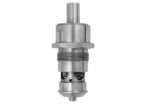
Thermal Bypass
Thermal bypass is necessary to control fluid temperature in hydraulic and lube oil systems used in industrial, mobile, aerospace, and defense applications. ThermOmegaTech’s thermostatic Thermal Bypass Valves (TBVs) provide precise temperature control by directing fluid through a cooler or bypassing it to prevent overheating or undercooling and enhance system efficiency in dozens of applications.
What is a Thermal Bypass Valve?
A thermal bypass valve is a critical component in various systems that requires fast warm-up, controlled fluid temperature, and low return line back pressure. It automatically regulates fluid flow to maintain optimal operating temperatures.
Fluids that are too hot can cause reduced fluid viscosity, internal leakage, pump cavitation, and eventual component failure. Fluids that are too cold increase fluid viscosity, resulting in high stress on system components. Proper fluid temperature control ensures mechanical components are lubricated and run at peak efficiency.
How Thermal Bypass Valves Work
Thermal bypass valves use a thermostatic element, a thermal actuator, that responds to fluid temperature to control it. When the fluid is below the desired temperature, the valve diverts it from the cooler to accelerate warming. Conversely, when the fluid exceeds the optimal temperature, the valve directs it through the cooler to reduce heat.
3-Way Thermal Bypass Valves
ThermOmegaTech’s 3-way mixing and diverting valves can be installed in mixing or diverting mode to provide a controlled outlet or system temperature. In diverting mode, the system temperature is controlled by monitoring inlet flow and automatically diverting the fluid to one of two outlet ports: outlet to cooler or outlet to bypass.
Fluid below the valve’s set-point temperature is bypassed to a reservoir or bypass loop, while fluid at or above the set-point is diverted to the system’s cooler. This configuration is commonly used in systems with a single heat exchanger.
Common applications for 3-way thermal bypass valves include:
- Engine oil cooling systems
- Hydraulic systems
- Lubrication oil cooling systems
4-Way Thermal Bypass Valves
A 4-way thermal bypass valve offers more complex control by incorporating an additional outlet port. This allows for more intricate fluid management, such as diverting fluid to multiple coolers or creating different flow paths based on specific temperature ranges.
ThermOmegaTech’s Thermal Bypass Valve with Pressure Relief (TBV-PR) can be installed into a manifold to control flow in these systems. This valve also has the added bonus of built-in pressure relief to prevent a system failure due to excessive pressure. This feature will override the valve to send flow through the bypass when pressure exceeds a predetermined threshold until pressure returns to a safe level in the system.
Common applications for 4-way thermal bypass valves include:
- Complex hydraulic systems
- Industrial cooling systems
- Aerospace and defense applications
By implementing thermal bypass valves, particularly 4-way valves, for complex systems, industries can achieve substantial advancements in process efficiency, quality, and overall operational performance.
If one of our standard products doesn’t meet your systems’ needs, contact one of our product specialists to discuss your project’s requirements. We design and manufacture all our thermal actuators in-house, giving us the unique ability to customize designs for your project’s needs. Customizations can be made to opening/closing temperatures, material, valve size, flow rates, number of inlets/outlets, and other optional features such as overrides.
